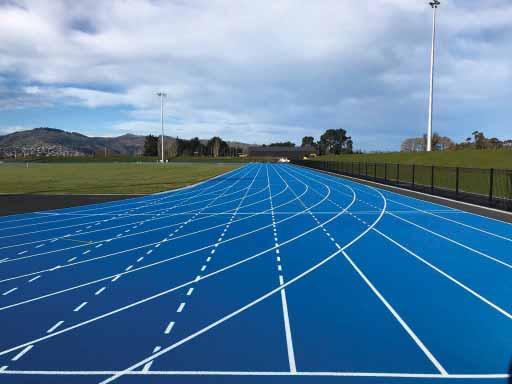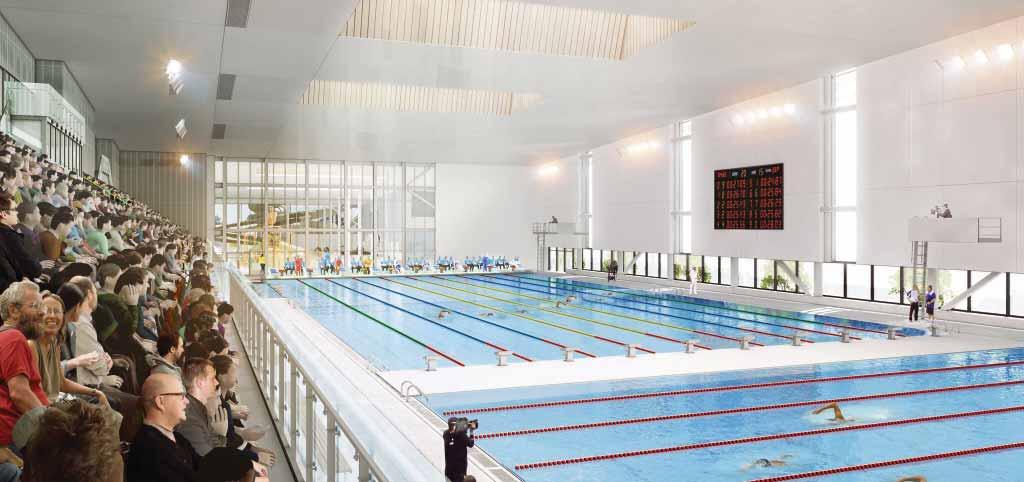
8 minute read
10 Years On
Richard Lindsay outlines how the sport and recreation sector has recovered from the Canterbury earthquakes
Aquatic fun at the new QEII Park. Nga Puna Wai is Christchurch’s new athletics facility (below).
Advertisement

In February we collectively reflected on the horrors that were experienced 10 years ago due to the Christchurch earthquakes. It was not surprising to see the levels of grief and sadness reflected in the anniversary commemorations. It is still a raw, real event that affected Cantabrians in many ways. Some lost family and friends, many lost their homes and many more lost their livelihoods. Some are still battling to be compensated for their losses while the loss of lives will never be forgotten.
Reflecting on the last decade from a sport and recreation perspective, and having been actively involved in the recovery process the key question I want to address is how has Canterbury fared, 10 years on?
Sport and recreation were the last thing on most people’s minds immediately after the February 2011 events. Rather, the focus was on rescuing trapped people and re-uniting families. There was a natural flight from Christchurch to other parts of New Zealand to seek safety and respite from the constant aftershocks. There was a sense of confusion and bewilderment as people began to pick up the pieces.
In a very short period (in some instances only a few days) efforts were made to re-engage communities and to provide some sense of normality for people. The true values of sport and recreation were confirmed. Social cohesion, community engagement and self-worth were gained through local and community level consultation. Sport and recreation organisations rallied together and offered casual games and activities for children and adults to escape the reality that surrounded them.
Investigations began, to understand what was damaged and what needed to be repaired, restored or replaced. Some of those looking from outside of Canterbury saw the situation as a blank canvas; an opportunity to completely re-imagine the sport and recreation landscape in the city and surrounding province. However, the reality was that while there were a significant number of damaged facilities, there were also a number that were unscathed or only in need of minor repairs. The other reality was it was not just the sport and recreation infrastructure that needed to be attended to; roads, houses, water, wastewater and other infrastructure also needed investment.
The government of the day was quick to establish an agency to support local government with the mammoth recovery process. The Canterbury Earthquake Recovery Agency (CERA) was set up and tasked with developing a recovery strategy. CERA was given unprecedented powers to oversee the recovery of Canterbury.
At around the same time the sport and recreation community was brought together by Sport Canterbury, Sport NZ and the Christchurch City Council (CCC) to understand recovery needs. This was formalised through the establishment of the Sport and Recreation Earthquake Leadership Group (SRELG). CERA recognised the organised approach of sport and recreation and requested that SRELG map out a recovery plan for the sector.
Ten years on as we look back, how has Canterbury fared? Here are some key observations that may help others who ever have to embark on a recovery process, regardless of the magnitude.

The concept for the new Christchurch Metropolitan Sports Facility (above) and liquefaction at the old QEII Park after the 2011 earthquake (below).
Although opportunity knocked, realism answered the door Many thought the earthquakes provided the platform to completely re-vision the entire network of facilities. The reality was a large number of sport and recreation assets only received minor damage or none at all. Most parts of the jig saw puzzle were still there. Some larger assets needed to be replaced (Lancaster Park, QEll, Centennial Pool), but it became apparent this was not a time when everything needed to be re-built. This was not a ‘blank canvas’ situation. Canterbury integrated recreation and sport into the CBD There was a strong drive to use recreation, sport and play as mechanisms to ignite the Central City Recovery Plan. The Metropolitan Sports Facility and the Multi-use Arena (stadium) were seen as key anchor projects for the CBD. The Margaret Mahy playground was one of the first anchor projects to be completed, offering Christchurch a world class destination playground.
The development of a more coherent, intuitive network of cycleways was also seen as a way of changing how Cantabrians commute. The Avon River corridor also encouraged an increase in biodiversity in the area with the northern side of the river designed to reflect the natural environment as much as practical. This has provided access for thousands of people each day to the river’s edge. Iwi were integral in ensuring the return of native flora to the area. Sport and recreation leadership created opportunities Compared with some sectors, sport and recreation was more united and galvanised. There were strong pre-existing relationships between local government, central government and the regional sports trust that allowed the recovery process to begin as soon as practical. CERA used SRELG to help develop a recovery plan for the sector and prioritise projects. Third party funders looked to this prioritisation and aligned their funding to maximise effect. Ongoing engagement requirements drained people The volume of requests to engage in processes and projects was too much for smaller organisations. ‘Consultation fatigue’ was often referred to, referring to people’s lack of energy to be consulted on again, often by different organisations for similar outcomes. Many smaller groups had few, if any, paid staff, with volunteers being required to advise on large scale projects. It was not necessarily the request for advice, rather the short timeframes that frustrated some groups. This led to an imbalance of power between sport specific groups and larger agencies seeking input. Timeframes were variable and changeable Some projects were completed very quickly. A high-profile example was the development of the temporary rugby stadium to host the Crusaders Super Rugby franchise (and other sports teams). The CCC worked with a number of groups and erected the stadium in around 100 days. A phenomenal effort.
Other projects had delays, many of which were out of the control of the sector. This led to frustration and mistrust in some avenues. Long delays in communication with stakeholders inputting into some projects magnified the problem. Temporary solutions potentially re-prioritised long-term solutions While the temporary rugby stadium breathed life into professional rugby in Christchurch, arguably the temporary solution allowed decision makers to place the development of a permanent solution on the backburners. It would be interesting to consider how long it would have taken to develop a new permanent home if Crusaders’ home games were all moved to Nelson or Timaru. While this would have placed enormous financial pressure on the franchise, the delivery of a permanent venue may have been prioritised. A high trust model of engagement achieved instant results The Canterbury earthquakes meant local knowledge and delivery was even more valuable for government agencies. Within the sport and recreation context SPARC (now Sport New Zealand) relied heavily on the local RST and Councils to lead the sector through the tumultuous early months. SPARC supported the recovery process through a high trust model of investment that allowed agencies to get things done without having to fit within prescribed outcome areas. This trust and flexibility lead to increased confidence in local deliverers and better outcomes for the wider sector.


The ‘temporary’ Orangetheory Stadium.
Valuable people were lost to the sector Many people involved in the recovery process no longer work in the sector. Research from the San Francisco earthquake recovery warned that those involved in the recovery process would either burn out or leave. This was mirrored in the Canterbury situation. Summary
Canterbury was king hit when earthquakes struck in 2010 and 2011. While not knocked out, it was on its knees. The sport and recreation sector bounced back remarkably well. The fact that children were back playing sport within a few weeks showed the resilience of communities and the importance of sport in the social fabric of many people’s lives.
As new facilities were planned, opportunities were implemented to inspire partnerships and collaboration. Multisport hubs were actively encouraged. Christchurch now has some facilities that will be considered world class such as Nga Puna Wai and the soon to open Metropolitan Sports Facility.
The recovery process was not easy. Stakeholders were frustrated by some delays, many of which were out of the control of those developing facilities. Future recovery agencies could consider appointing more sector facing stakeholder

The Margaret Mahy Family Playground.
managers, tasked with ensuring two-way communication that is ongoing and transparent.
The next generation of residents and visitors will be able to experience world class facilities in their own region. They may not know the full back story of how we have got to here, but that does not matter, provided the sector is healthy, vibrant and adaptable and people are participating in play, recreation and sport activities of their choice. The recovery of Canterbury has set up the region for the next 50 years. Let us hope that if others have to go through any form of recovery process, they can learn from the Canterbury experience and get up from the canvas stronger. Richard Lindsay is Managing Director of consultancy RSLC. He has worked in the sport and recreation sectors for over 25 years in central and local government, not-forprofit and commercial organisations. He can be reached on 021 274 6540, www.rslc.nz













